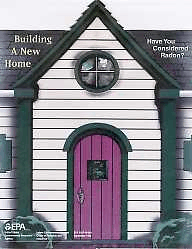|
United States Environmental Protection Agency
What
You Should Know About Radon There are so many things to consider when having a new home built - so many choices to make. How many bedrooms should you have? Is the kitchen large enough? Do you need a basement? You may even be concerned about environmental issues, such as the fumes from new building materials and furnishings. But are you concerned about radon? You should be. What You Should Know About Radon Radon is a radioactive gas that comes from the soil. Exposure to radon gas it the second-leading cause of lung cancer (after smoking) in the United States. About 14,000 people die each year from radon-related lung cancer. Radon is produced from the natural breakdown of the uranium found in most rocks and soils. As it further breaks down, radon emits atomic particles. These particles are in the air we breathe. Once inhaled, they can be deposited in our lungs. The energy associated with these particles can alter cell DNA, thus increasing the risk of lung cancer. Radon usually does not present a health risk outdoors because it is diluted in the open air. Radon can, however, build up to dangerous levels inside a house. Radon can enter your new house through cracks or openings in the foundation. The differences in air pressure between the inside of a building and the soil around it also play an important role in radon entry. If the air pressure of a house is greater than the soil beneath it, radon will remain outside. However, if the air pressure of a house is lower than the surrounding soil (which is usually the case), the house will act as a vacuum, sucking radon gas inside. Because radon comes from the soil, the geology of an area can help to predict the potential for elevated indoor radon levels. The U.S. Environmental Protection Agency (EPA) has worked with state and federal geologists to develop maps which predict the potential indoor radon levels for every county in the United States. Those counties with the highest potential are designated as Zone 1; those with the lowest comprise Zone 3. Zone 1 areas have predicted average radon levels at or above the EPA's 4.0 pico-Curies per liter (pCi/L) action level. (pCi/L is a measure of the amount of radioactivity in a known quantity of air.) To determine which radon zone your new house will be built, please contact your State radon office. If you are building in a Zone 1 county, you should include a radon control system in your new home. It is an inexpensive addition to the total cost of your house and is an easy way to protect you and your family. You and your builder can design your new house to be radon resistant. For $350 to $500, on average, your builder can take the following four simple steps to deter radon from entering your home.
These construction techniques will be familiar to your builder. There is no need to hire a special contractor or architect. Many builders already incorporate some of these steps in the construction of their houses to control moisture or increase energy efficiency. In fact, radon-resistant construction techniques can be found in the 1995 version of the One-and-Two Family Dwelling Code published by the Council of American Building Officials. The radon-resistant construction techniques described in this brochure comprise a "passive" radon system. This system overcomes the vacuum effect experienced by most houses by creating a pressure barrier to radon entry. The system also includes a pipe to vent radon gas safely to the outdoors. Sometimes a passive radon system isn't enough to prevent radon from entering a house. In this case, a fan can be installed to pull the radon gas from the underlying soil into the vent pipe where it can be exhausted outside the house. The addition of a fan and its associated wiring creates and "active" radon system. The only way to know if your new home has a radon problem is to test. The EPA recommends that average annual indoor radon levels do not exceed 4.0 pCi/L. If your home is built with a passive radon system, you should test it immediately after moving in to make sure that radon levels are below the EPA guideline. Remember: If your radon level is 4.0 pCi/L or above, a fan can be installed easily to lower radon levels well below this guideline. Even if you must install a fan, adding a radon control system to a house under construction is much less expensive than installing one after the house is built. The average cost for a radon control system in an existing house is between $500 and $2,500. Adding radon-resistant construction now will save you unnecessary expense and worry later. For Architectural Drawings and Technical Information Detailed model building standards, architectural drawings of radon systems, and fact sheets on alternative radon installations are available from EPA at no charge by phoning 1-800-55-RADON (1-800-557-2366). A growing number of municipalities located in areas known to have high radon potential now require or recommend that passive radon systems be installed in all new houses. Contact your State Radon Office to determine if you are building your new home in such an area. Many publications and resources are available to you for free. Here are just a few suggestions:
To gain more information about building a radon-resistant house or testing an existing home, please contact the Radon Office in your State. EPA Home
| OAR Home | IAQ
Home | Radon Home
Privacy | Comments?
| Search IAQ |

